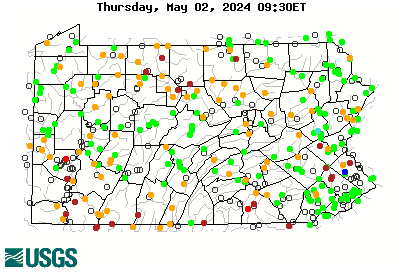pcray1231
Well-known member
Interesting on Jeans. I buy the acidification argument. The numbers shown do not reflect my experiences on size at all, they run pretty big, and I catch plenty in the 7-10" range on every trip, and there have been a couple in the 10-12 range too. I suspect they do the shocking either near the mouth or up on top rather than in the heart of it. And yeah, they run smaller in those areas. No mention of browns either, though they are present.
Silver, yes, the number of trout 7" or longer has always been a very poor metric, IMO. Very arbitrary, when the PFBC already admits harvest is nil, 7" fails to carry any significance whatsoever from a conservation standpoint. Just my opinion. I like to catch bigger fish for any population, but it's relative to the population. There are streams where 2 and 3 inchers are the normal and you consider a 5" as a "nice fish", and a 7 incher is a monster. And that's fine. And there are tons of streams where 5-8 inchers are normal, 8-10 is a "nice fish" with a 10-12 being a hoss fish. A lot of brown trout streams where 10-12 is normal, mid teens is a "nice fish", and anything 17 or above is a hoss. And then you go all the way to steelhead, where anything under 20 is "just a jack", 24" is an average fish, and 30 is where monster territory begins.
And as in Jeans, a lot of these streams the size varies, often inversely with the population. They don't become more or less valuable when a population falls and size gets better, nor do they become better or worse if the population spikes and size goes down. That's just the nature of that stream.
Silver, yes, the number of trout 7" or longer has always been a very poor metric, IMO. Very arbitrary, when the PFBC already admits harvest is nil, 7" fails to carry any significance whatsoever from a conservation standpoint. Just my opinion. I like to catch bigger fish for any population, but it's relative to the population. There are streams where 2 and 3 inchers are the normal and you consider a 5" as a "nice fish", and a 7 incher is a monster. And that's fine. And there are tons of streams where 5-8 inchers are normal, 8-10 is a "nice fish" with a 10-12 being a hoss fish. A lot of brown trout streams where 10-12 is normal, mid teens is a "nice fish", and anything 17 or above is a hoss. And then you go all the way to steelhead, where anything under 20 is "just a jack", 24" is an average fish, and 30 is where monster territory begins.
And as in Jeans, a lot of these streams the size varies, often inversely with the population. They don't become more or less valuable when a population falls and size gets better, nor do they become better or worse if the population spikes and size goes down. That's just the nature of that stream.





